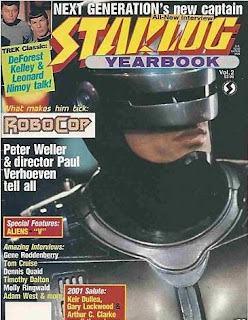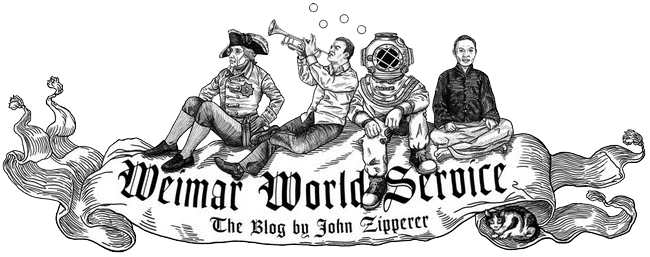 Learn from your elders. That's not a bad idea, and it's an idea I heard long ago from a magazine and newspaper editor to whom I may or may not be closely related.
Learn from your elders. That's not a bad idea, and it's an idea I heard long ago from a magazine and newspaper editor to whom I may or may not be closely related.What it means in practice in the publishing arena is to not be afraid to see what works in other publications and adapt those ideas to your publication.
This did not become clear to me until I visited a little bookstore in San Francisco called Kayo Books, which focuses on (and sort of fetishizes) the 1950s and '60s. I saw some inexpensive copies of '50s-era Playboy magazines, and I bought some.
It was fascinating to see the early years of a magazine that became a behemoth of the periodicals industry (and several other industries). Reading the editorials and subscription ads and the text that referenced its readership made it very clear that the magazine had pretensions -- pretentions it had not yet met; but issue after issue, it improved and got closer to that manufactured self-image.

In short, Playboy was aping Esquire in many ways, even while it was clearly going beyond and above it in terms of quality and success. Playboy has a long history of award-winning and stunning cover treatments, but it was only when I saw those early issues of Playboy and then -- wow -- saw contemporary issues of Esquire that I realized that Playboy's (and, by that, I assume I mean Hugh Hefner, the former Esquire employee who started his magazine after being denied a raise; but it might also include his art staff) view of its audience and itself owed an immense debt to Esquire.
It's not just the cover designs that were clearly done with an eye to the market leader. Those '50s issues of Playboy were almost painfully earnest in their attempt to reach the ivy league young professional, the educated "gentleman" (oh, if only either magazine tried to reach educated gentlement today, the world would be a better place) seeking to learn what it takes to be independent and successful in the post-war world.
 That was Esquire's market.
That was Esquire's market.I saw something similar when I spent more time looking into Famous Monsters, the Jim Warren-published movie monster magazine th
 at paved the way for such competitors as Fantastic Films, Starlog, Fangoria, and others. Like Playboy, Starlog was known for years as a creative and confident powerhouse in its publishing market. In its first half-dozen years, in addition to its monthly magazine and its many spinoffs, it published poster magazines, best-of collections, LP albums of movie music, high-quality paperback books, photo collections, foreign editions, a children's book by Boris Vallejo, calendars, t-shirts, licensed movie magazines, and more, and would soon launch live conventions. It was a great time to be a science-fiction geek.
at paved the way for such competitors as Fantastic Films, Starlog, Fangoria, and others. Like Playboy, Starlog was known for years as a creative and confident powerhouse in its publishing market. In its first half-dozen years, in addition to its monthly magazine and its many spinoffs, it published poster magazines, best-of collections, LP albums of movie music, high-quality paperback books, photo collections, foreign editions, a children's book by Boris Vallejo, calendars, t-shirts, licensed movie magazines, and more, and would soon launch live conventions. It was a great time to be a science-fiction geek. But Famous Monsters had done a number of those things first (such as best-of "yearbook" collections, licensed movie mags, and conventions), and that realization has only fairly recently come to me. After all, I was too young to appreciate Famous Monsters; I found it to be juvenile and low-quality; as a 'tweener in the late '70s, early '80s, I much preferred the Starlog approach that inspired me to play with ideas and controversies, and that also gave me lots of color pages and professional-quality features.
But Famous Monsters had done a number of those things first (such as best-of "yearbook" collections, licensed movie mags, and conventions), and that realization has only fairly recently come to me. After all, I was too young to appreciate Famous Monsters; I found it to be juvenile and low-quality; as a 'tweener in the late '70s, early '80s, I much preferred the Starlog approach that inspired me to play with ideas and controversies, and that also gave me lots of color pages and professional-quality features.But Starlog-partisan that I am, I have to admit now that the magazine would have been radically different had FM not existed. That's not to take anything away from all of the people who worked hard on Starlog -- or, for that matter, on Famous Monsters or Playboy or Esquire. It's just a recognition of when a great title is more an evolution than a revolution.
What interested me about it is that both Playboy and Starlog came to dominate the markets created by the magazines from which they were drawing ideas. And noticing their creative debt to other magazines is both disconcerting and a little endearing.

Playboy borrowed a lot of ideas from Esquire; Starlog borrowed a lot from Famous Monsters. It's not just a matter of taking from what came before. Starlog wasn't stealing very many ideas from Cinefantastique, another pre-existing competitor. Playboy certainly was avoiding the men's adventure mags that also flourished before it came to dominate the market.
And that is the point, and I think the lesson for magazine creators today: Starlog and Playboy borrowed from the leading publications in their fields, not just any publications in their fields, because both Hugh Hefner and Starlog's Norman Jacobs and Kerry O'Quinn had expectations of great success and of leading their respective fields. So why not learn from, and imitate, the best?

No comments:
Post a Comment